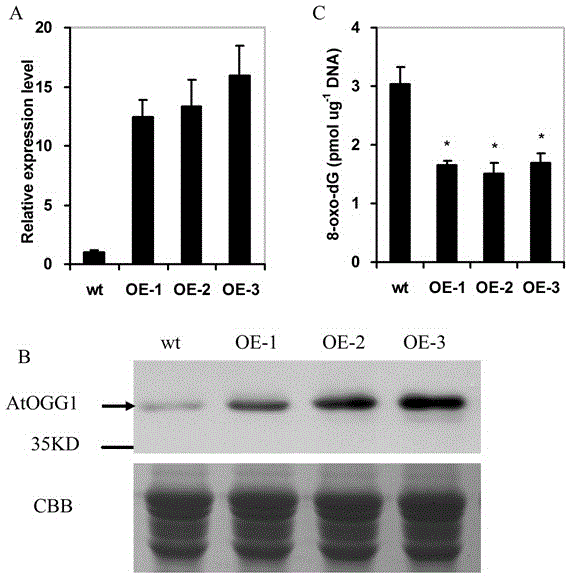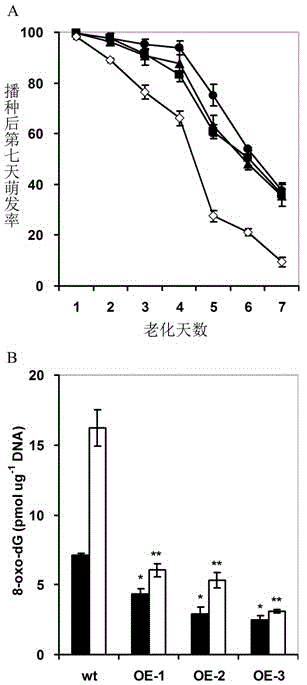Application of arabidopsis DNA (Deoxyribonucleic Acid) glycosidase AtOGG1 in aspects of prolonging life of seed and improving germination vigor of seed
A technology of Arabidopsis thaliana and glycosidase, applied in the field of plant genetic engineering, can solve the problems of plant tissue damage, inability to exercise normally, cell rupture, etc., and achieve the effects of improving storage life and vitality, important economic benefits and application prospects
- Summary
- Abstract
- Description
- Claims
- Application Information
AI Technical Summary
Problems solved by technology
Method used
Image
Examples
Embodiment 1
[0026] Example 1 Arabidopsis thaliana DNA glycosidase protein gene AtOGG1 Cloning of full-length gene cDNA
[0027] (1) Preparation of Arabidopsis leaves: wild-type Arabidopsis ( Col-0 ) 2 weeks after the seeds germinated, the leaves were collected.
[0028] (2) Extraction of total RNA: Total RNA was extracted using Trizol product from Invitrogen Company.
[0029] (3) Obtaining cDNA: The RNA in (2) was reverse transcribed using the instructions of Takara's PrimeScript 1st Strand cDNA Synthesis Kit to obtain cDNA.
[0030] (4) get AtOGG1 Full-length cDNA of the gene: the obtained cDNA is used as a template, primers are designed according to the sequence published by GenBank (accession number is NM-102020), and obtained by PCR amplification AtOGG1 Gene, confirmed by sequencing. The PCR primers are as follows:
[0031] Forward primer: SEQ ID NO: 1: 5'- ACGGCGATGAAGAGACCTCGACCT- 3';
[0032] Reverse primer: SEQ ID NO: 2: 5'-AATAACTACGCTCATTTGCCAGGG-3'.
Embodiment 2
[0033] The construction of embodiment 2 plant expression vectors
[0034] (1) Cloning of gene fragments
[0035] Arabidopsis thaliana described in Example 1 AtOGG1 The full-length cDNA of the gene is used as a template, and the restriction site is added by PCR cloning Sma I and Sac PCR fragment of I. The PCR primers are as follows, the underlined part is the restriction site:
[0036] Forward primer: SEQ ID NO:3: 5'-TCC CCCGGG ATGAAGAGACCTCGACCTAC-3';
[0037] Reverse primer: SEQ ID NO:4: 5'-C GAGCTC TCATGGCTTCAACGTATCAC-3'.
[0038] PCR reaction system: 1 μL AtOGG1 Gene, 5 μL dNTP (2.5 mM), 2 μL MgCl 2 1.5 μL forward primer (10 μM), 1.5 μL reverse primer (10 μM), 5 μL 10×PCR buffer, 1 μL KOD plus enzyme (product of TOYOBO), and finally add deionized water to make the total system 50 μL. The reaction conditions of PCR are: 94°C for 5 minutes; then enter the following cycle: 94°C for 30 seconds, 60°C for 45 seconds, 72°C for 70 seconds, a total of 28 cycles; f...
Embodiment 3
[0049] Example 3 Genetic Transformation of Arabidopsis
[0050] 1. Pre-treatment of Arabidopsis transformation
[0051] When the main moss of Arabidopsis thaliana grows to 5-6 cm, cut off the whole inflorescence at the base of the inflorescence, and remove the dominance of its apex. After 1 week, 4-6 new side mosses will grow on the axillary buds, and wait for the side mosses to form flower buds and form. Partial flowering or the formation of 1-2 siliques can be used for transformation, and the grown siliques need to be cut off before transformation. The day before transformation, the plants were well watered and covered with a plastic bag to maintain a high humidity environment.
[0052] 2. Preparation of Infection Medium
[0053] The composition of the dipping medium used for soaking Arabidopsis tidbits is 1 / 2MS medium containing 5% (mass) sucrose, pH=5.8 (adjusted with 1M KOH), autoclaved. When using, add 0.02%~0.05% (mass) surfactant Silwet L-77 and shake well.
[00...
PUM
 Login to View More
Login to View More Abstract
Description
Claims
Application Information
 Login to View More
Login to View More - R&D Engineer
- R&D Manager
- IP Professional
- Industry Leading Data Capabilities
- Powerful AI technology
- Patent DNA Extraction
Browse by: Latest US Patents, China's latest patents, Technical Efficacy Thesaurus, Application Domain, Technology Topic, Popular Technical Reports.
© 2024 PatSnap. All rights reserved.Legal|Privacy policy|Modern Slavery Act Transparency Statement|Sitemap|About US| Contact US: help@patsnap.com










